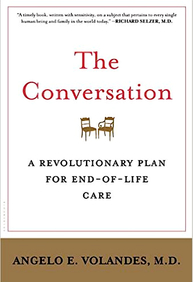A WRITER'S WIT |
My Book World

Medical Doctor Volandes offers a plan for terminal patients to share with their family members and loved ones concerning how and when their lives should end. He informs the reader that “only 24 percent of Americans older than sixty-five die at home; 63 percent die in hospitals or nursing homes, sometimes tethered to machines, and often in pain” (3). He blames the medical profession—doctors like him—for their failure “to have discussions with patients about how to live life’s final chapter” (3). If you should become a terminally ill patient, you must have The Conversation with your doctor.
I am reminded of a scene from the Mike Nichols’s 2001 HBO film Wit (based on Margaret Edson’s play), starring Emma Thompson as a highly educated woman dying from late-stage Ovarian cancer. A kind nurse played by Audra McDonald asks Thompson what her wishes are when her heart stops. Thompson indicates she prefers DNR status: Do Not Resuscitate. Thompson’s young intern, a former university student of hers, makes an error on her chart, and the Full Code treatment to revive her ensues instead. McDonald, fortunately, is on hand to remind the doctor, and Thompson is allowed to die in relative peace—as she’s wished. All too often, according to Volandes, Americans are not afforded the courtesy of having The Conversation, and patients are subject to CPR, when statistics show that only a small number of the elderly survive such efforts.
At the same time, Volandes explains that medical doctors are trained in the following manner: “To doctor patients is to learn how not to die” (8). They and their staffs often can’t help themselves. With all the lifesaving equipment and procedures available to them, physicians forget the old saw, “First, do no harm,” and forge ahead because they can. Volandes states, “Patients can drive change by having greater knowledge of their options, while doctors can drive change by communicating and advocating for those choices . . . every doctor knows that in the end, we all find ourselves on the patient’s side of the stethoscope” (9).
Most of the research, he tells us, indicates that terminal patients are healthier and have a better outlook at the end of their lives if they know what their choices are, and the two choices are pretty much this: you either want to be at home, made comfortable with pain control, or you want to be Full Code, where the hospital staff does everything to keep you alive until your loved ones say “Turn it off.” The doctor’s book is simply written and lacks the dry, overladen rhetoric of medical speak. Instead, he employs moving anecdotes about patients facing the end of their lives, including one about his own father. He describes the video he produces to screen for patients and their loved ones to help them decide how their lives should end, instead of, defaulting to the hospital.
I plan to keep The Conversation handy and study it when and if the time arrives. I could always get hit by a truck!
NEXT TIME: New Yorker Fiction 2016

Introduction to My Long-Playing Records
"My Long-Playing Records" — The Story
"A Certain Kind of Mischief"
"Ghost Riders"
"The Best Mud"
"Handy to Some"
"Blight"
"A Gambler's Debt"
"Tales of the Millerettes"
"Men at Sea"
"Basketball Is Not a Drug"
"Engineer"
"Snarked"
"Killing Lorenzo"
"The Age I Am Now"
"Bathed in Pink"
Listen to My Long-Playing Records Podcasts:
"A Certain Kind of Mischief"
"The Best Mud"
"Handy to Some"
"Tales of the Millerettes"
"Men at Sea"
"My Long-Playing Records"
"Basketball Is Not a Drug"
"Snarked"
"Killing Lorenzo"
"Bathed in Pink"
Also available on iTunes.


 RSS Feed
RSS Feed